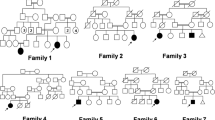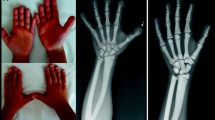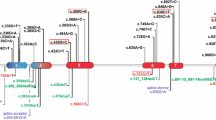Abstract
Pycnodysostosis is a rare autosomal recessive skeletal dysplasia characterized by short stature, osteosclerosis, acro-osteolysis, frequent fractures, and skull deformities. Mutation in the gene encoding cathepsin K (CTSK), which is a lysosomal cysteine protease, has been found to be responsible for this disease. Here we reported a consanguineous Chinese family with 1 affected individual demonstrating autosomal recessive pycnodysostosis with recurrent kidney stone, a new clinical manifestation which has not been reported in patients of pycnodysostosis before. To identify the pathogenic mutation, we evaluated the patient clinically, biochemically, and radiographically. To screen for mutations in the CTSK gene of the patient and his family members, all of its exons and exon–intron junctions were PCR amplified from genomic DNA and sequenced. Sequence analysis of the patient’s CTSK gene revealed homozygosity for a missense mutation (c.746T>C) in exon 6, which leads to amino change (p.Ile249Thr) in the mature CTSK protein. This mutation was firstly reported by Michela Donnarumma and his colleagues in 2007 in a Spanish family. Our study strengthens the role of this particular mutation in the pathogenesis of pycnodysostosis.



Similar content being viewed by others
References
Maroteaux P, Lamy M (1962) La pycnodysostose. Presse Med 70:999–1002
Maroteaux P, Lamy M (1965) The malady of Toulouse-Lautrec. JAMA 191:715–717
Soliman AT, Ramadan MA, Sherif A, Aziz BE, Rizk MM (2001) Pycnodysostosis: clinical, radiologic, and endocrine evaluation and linear growth after growth hormone therapy. Metabolism 50:905–911
Varol A, Sabuncuoglu FA, Sencimen M, Akcam T, Olmez H, Basa S (2011) Rigid external maxillary distraction and rhinoplasty for pyknodysostosis. J Craniofac Surg 22:901–904
Della MG, Scarano E, Leoni C, Dittoni S, Losurdo A, Testani E, Colicchio S, Gnoni V, Vollono C, Zampino G (2012) Pycnodysostosis with extreme sleep apnea: a possible alternative to tracheotomy. Sleep Breath 16:5–10
Hernandez-Alfaro F, Arenaz BJ, Serra SM, Mareque BJ (2011) Orthognathic surgery in pycnodysostosis: a case report. Int J Oral Maxillofac Surg 40:110–113
Mujawar Q, Naganoor R, Patil H, Thobbi AN, Ukkali S, Malagi N (2009) Pycnodysostosis with unusual findings: a case report. Cases J 2:6544
Gelb BD, Edelson JG, Desnick RJ (1995) Linkage of pycnodysostosis to chromosome 1q21 by homozygosity mapping. Nat Genet 10:235–237
Polymeropoulos MH, Ortiz DLR, Ide SE, Torres R, Rubenstein J, Francomano CA (1995) The gene for pycnodysostosis maps to human chromosome 1cen-q21. Nat Genet 10:238–239
Gelb BD, Shi GP, Chapman HA, Desnick RJ (1996) Pycnodysostosis, a lysosomal disease caused by cathepsin K deficiency. Science 273:1236–1238
Donnarumma M, Regis S, Tappino B, Rosano C, Assereto S, Corsolini F, Di Rocco M, Filocamo M (2007) Molecular analysis and characterization of nine novel CTSK mutations in twelve patients affected by pycnodysostosis. Mutation in brief #961. Hum Mutat 28:524
Inaoka T, Bilbe G, Ishibashi O, Tezuka K, Kumegawa M, Kokubo T (1995) Molecular cloning of human cDNA for cathepsin K: novel cysteine proteinase predominantly expressed in bone. Biochem Biophys Res Commun 206:89–96
Saftig P, Hunziker E, Wehmeyer O, Jones S, Boyde A, Rommerskirch W, Moritz JD, Schu P, von Figura K (1998) Impaired osteoclastic bone resorption leads to osteopetrosis in cathepsin-K-deficient mice. Proc Natl Acad Sci USA 95:13453–13458
Gowen M, Lazner F, Dodds R, Kapadia R, Feild J, Tavaria M, Bertoncello I, Drake F, Zavarselk S, Tellis I, Hertzog P, Debouck C, Kola I (1999) Cathepsin K knockout mice develop osteopetrosis due to a deficit in matrix degradation but not demineralization. J Bone Miner Res 14:1654–1663
Li CY, Jepsen KJ, Majeska RJ, Zhang J, Ni R, Gelb BD, Schaffler MB (2006) Mice lacking cathepsin K maintain bone remodeling but develop bone fragility despite high bone mass. J Bone Miner Res 21:865–875
Uusitalo H, Hiltunen A, Soderstrom M, Aro HT, Vuorio E (2000) Expression of cathepsins B, H, K, L, and S and matrix metalloproteinases 9 and 13 during chondrocyte hypertrophy and endochondral ossification in mouse fracture callus. Calcif Tissue Int 67:382–390
Lazner F, Gowen M, Kola I (1999) An animal model for pycnodysostosis: the role of cathepsin K in bone remodelling. Mol Med Today 5:413–414
Gowen M, Lazner F, Dodds R, Kapadia R, Feild J, Tavaria M, Bertoncello I, Drake F, Zavarselk S, Tellis I, Hertzog P, Debouck C, Kola I (1999) Cathepsin K knockout mice develop osteopetrosis due to a deficit in matrix degradation but not demineralization. J Bone Miner Res 14:1654–1663
Kiviranta R, Morko J, Alatalo SL, NicAmhlaoibh R, Risteli J, Laitala-Leinonen T, Vuorio E (2005) Impaired bone resorption in cathepsin K-deficient mice is partially compensated for by enhanced osteoclastogenesis and increased expression of other proteases via an increased RANKL/OPG ratio. Bone 36:159–172
Saftig P, Hunziker E, Wehmeyer O, Jones S, Boyde A, Rommerskirch W, Moritz JD, Schu P, von Figura K (1998) Impaired osteoclastic bone resorption leads to osteopetrosis in cathepsin-K-deficient mice. Proc Natl Acad Sci U S A 95:13453–13458
Li HY, Ma HW, Wang HQ, Ma WH (2009) Molecular analysis of a novel cathepsin K gene mutation in a Chinese child with pycnodysostosis. J Int Med Res 37:264–269
Zheng H, Zhang Z, He JW, Fu WZ, Zhang ZL (2013) A novel mutation (R122Q) in the cathepsin K gene in a Chinese child with Pyknodysostosis. Gene 521:176–179
Acknowledgments
We appreciate our patient and their families for their participating in this study. This study was supported by a grant from the Ministry of Science and Technology of the People’s Republic of China (National Science and Technology Major Projects for “Major New Drugs Innovation and Development” 2008ZX09312-016), National Natural Science Foundation of China (No. 81070687 and 81170805), Beijing Natural Science Foundation (No. 7121012), Scientific Research Foundation of Beijing Medical Development (No. 2007-3029), and National Key Program of Clinical Science (WBYZ2011-873). All listed authors have each made substantial contributions to conception and design, acquisition of data, or analysis and interpretation of data; participated in drafting the manuscript or revising it critically for content; and have approved the final version of the submitted manuscript. Dr. Xiang-Lan Huang, Dr. Xuan Qi, and Prof. Wei-Bo Xia accept responsibility for the integrity of the data analysis.
Conflict of Interest
The authors declare that there is no conflict of interest regarding the publication of this paper.
Human and Animal Rights and Informed Consent
Informed consents and approvals from the Department of Scientific Research at Peking Union Medical College Hospital (PUMCH), the local ethic committee, were obtained before the study.
Author information
Authors and Affiliations
Corresponding author
Additional information
Xianglan Huang and Xuan Qi have contributed equally to this work and should be regarded as co-first authors.
Rights and permissions
About this article
Cite this article
Huang, X., Qi, X., Li, M. et al. A Mutation in CTSK Gene in an Autosomal Recessive Pycnodysostosis Family of Chinese Origin. Calcif Tissue Int 96, 373–378 (2015). https://doi.org/10.1007/s00223-015-9963-y
Received:
Accepted:
Published:
Issue Date:
DOI: https://doi.org/10.1007/s00223-015-9963-y




